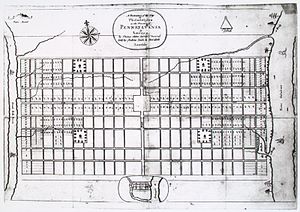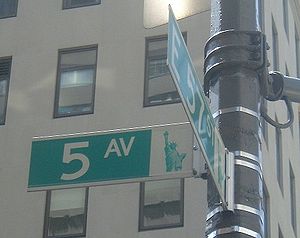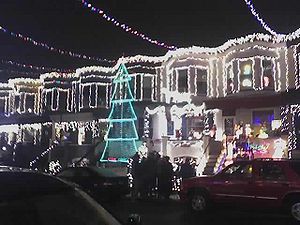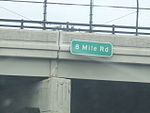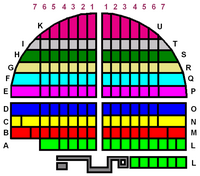- Numbered street
-
A numbered street is a street whose name is an ordinal number, as in Second Street or Tenth Avenue. Such forms are among the most common street names in North America, but also exist in other parts of the world, especially in the Middle East. Numbered streets were first used in Philadelphia [1] and now exist in many major cities and small towns. Grid-based naming systems usually start at 1 (but sometimes at a higher number), and then proceed in numerical order. In the United States, seven out of the top ten most common street names are numbers, with the top three names being "2nd," "3rd," and "1st" respectively.[2]
Some cities also have lettered street names. For example, Washington, D.C., in addition to having numbered streets, also has streets identified as a letter followed by "Street," going as high as the letter W. New York City (mostly in Brooklyn) has avenues titled "Avenue" followed by the respective letter of the alphabet, such as Avenue D. The idea for such a system was developed by Pierre Charles L’Enfant, who devised the system for Washington.
The numbered street system is criticized for taking away the individuality from a community that a named street would provide[3].
Contents
By place
United States
Philadelphia
Central Philadelphia was laid out by Thomas Holme in 1683 [4] and was the first city to use numbered streets systematically. While the original plan had two sets of north-south numbered streets, one parallel to the Delaware River and one to the Schuylkill, all are now numbered from the Delaware, with numbers increasing westward. First Street has been known as Front Street, and Fourteenth Street as Broad Street, since the founding of the city. The highest numbered street is 90th Street.[5] In Southwest Philadelphia, the grid is oblique, with numbered streets running from northwest to southeast. The numerical sequence is consistent with the numbering in adjacent West Philadelphia, and still increases from east to west. Because of the twist, however, the sequence is not consistent with the numbering in South Philadelphia, across the Schuylkill River[6].
The Kensington area has streets lettered "A" through "O". The East Oak Lane and West Oak Lane sections of the city contains east-west streets numbered from 64th Avenue to 80th Avenue, with the numbers correspondent with the block numbers north from Market Street.[7]
In the early 20th century, many of Chestnut Hill's previously numbered streets were renamed for Native American tribes.[8]
New York City
The Commissioners' Plan of 1811 laid out the grid that covers most of Manhattan today. Most west-east streets (which actually run northwest-southeast) are named "___th Street", and a few major north-south streets (which actually run northeast-southwest, roughly parallel to the island's long axis) are named "___th Avenue".
The highest-numbered street on Manhattan Island is 220th Street, and the highest-numbered street in the Borough of Manhattan is 228th Street, though numbered streets go higher in Queens and the Bronx, where numbered avenues and other road types also exist. In Brooklyn, there are ten sets of numbered streets (unprefixed numbered streets as well as North, South, East, West, Bay, Brighton, Paerdegat, Plumb, and Flatlands numbered streets), along with numbered avenues up to 28th Avenue and letter avenues up to Avenue Z. Manhattan's Alphabet City consists of Avenues A through D. The Rockaways section of Queens has streets prefixed with the word Beach. However, street signs in this area typically identify this prefix using only the letter B (e.g. "B 116 St"). The neighborhood of Broad Channel also has its own network of numbered roads, prefixed with East or West, relative to Cross Bay Boulevard.
The closest cross street to a given building number in Manhattan can be estimated using the Manhattan address algorithm.
The highest-numbered street in all of the New York area is 271st Street, located in New Hyde Park. The highest-numbered Avenue in Manhattan is the very obscure 13th Avenue, on Gansevoort Peninsula in the Hudson River just north of Gansevoort Street. Currently, only one unmarked block remains, currently used as a garbage truck access behind the Bloomfield Street Sanitation Depot. The street was once longer, but much of the land it was built on was removed to provide longer piers for berthing larger ships, such as the RMS Lusitania and RMS Titanic, without protruding further into the Hudson River. 12th Avenue is the highest numbered avenue that is signed by the city and accessible to the public. Higher-numbered avenues exist in other boroughs.
Washington, D.C.
Main article: Streets and highways of Washington, D.C.Pierre L'Enfant's plan for Washington, D.C. includes both radial avenues and grid system consisting of both numbered and lettered streets. North-south streets are named with numbers, such as "7th Street," and west-east streets are named with letters, such as "H Street." The name is then followed with a directional suffix (NW, NE, SW, or SE), specifying a quadrant of the city (e.g. 16th Street Northwest. The quadrants meet at the U.S. Capitol building.[9]
Within the city, the quadrants are divided by three streets known as North, East, and South Capitol Streets, and by the National Mall, which takes the place of the non-existent West Capitol Street. Numbers start counting upward on either side of North and South Capitol Streets, and letters start counting upward on either side of East Capitol Street and the National Mall.
Baltimore
The city of Baltimore, Maryland, has numbered streets in the north-central part of the city. The numbered streets in Baltimore do not begin with 1, but rather start with 20th Street just north of and parallel to North Avenue, the former northern boundary of the city, and what is viewed by many today is the northern boundary of Downtown Baltimore. The numbered streets, which go as high as 43rd Street, correspond with the first two digits in the addresses of the north-south streets they cross. Unlike in Washington, where the numbered streets run north-south, Baltimore's numbered streets run west-east. All begin their names with either "West" or "East," depending on which side of Charles Street the block is located.
Some of Baltimore's numbered streets are well-known for various reasons. 28th and 29th streets, a one-way pair, are the only numbered streets to have an interchange with I-83. They use the numbered designations to the east of the expressway, and to the west, they merge into a six-lane road known as Druid Park Lake Drive. East 33rd Street was the location of the now-demolished Memorial Stadium, home to the Baltimore Orioles for 38 years and the Baltimore Colts for 31. West 34th Street is the location of the annual Miracle on 34th Street, where residents on one block of the street open their porches to tourists to view their holiday decorations. West 40th Street is the location of The Rotunda shopping mall, and it merges into West 41st Street, which crosses over (but does not have an interchange with) I-83 into Television Hill and is the only numbered street in the city west of I-83.
Chicago
Main article: Streets and highways of ChicagoThe City of Chicago is set on a grid with eight "standard" city blocks per mile. Some blocks are further divided in half. A standard block has 100 address numbers, meaning there are 800 numbers per mile. Chicago address numbering begins downtown at State Street and Madison Street; State Street is 0 east and west, and Madison Street is 0 north and south. Major streets a mile apart have address numbers that, for the most part, are multiples of 800.
The south side of the city uses numbered east-west streets, although older streets that were already named retained their names, particularly in the Loop. The lowest numbered street is 8th street, which is (per the grid) approximately one mile south of Madison, followed by 9th street then Taylor (which was retained instead of 10th St), etc. In some cases, particular blocks or regions of numbered streets retain the older name (Fillmore St for 11th St and Pershing for 39th St. for instance).
The numbering within Chicago is continued throughout many suburbs south of the city proper. For instance, Chicago Heights has a 185th Street, set on the same numbering schema.
Chicago's numbered street system was adopted in 1911 as a result of new legislation. Madison Street was made the base for all street numbering, and State Street for north-south streets[10].
Cleveland
As a general rule, the only numbered streets in Cleveland run—generally—north-south, while streets that run parallel to the lake shore (generally east-west) have names rather than numbers. Ontario Street in downtown Cleveland separates east- and west-numbered streets, with the numbers increasing as one travels further away from Ontario. Conforming east-west roads are given a name, rather than a number, and the suffix "Avenue." Where an avenue crosses Ontario street or the Cuyahoga River, its name changes, meaning that a numbered street does not intersect a given avenue more than once. For example, stating a location as "65th and Detroit" implies West 65th street, since Detroit Avenue changes to Superior Avenue when it crosses the river. Non-conforming streets are suffixed with names other than "street" or "avenue," e.g., West Boulevard, Old River Road, Martin Luther King Jr. Drive. Geographic idiosyncrasies in certain parts of the city mean that this is by no means an absolute rule, but generally applies 95% of the time when within the city proper.
Miami
In Greater Miami, numbered streets go into three digits, with varying, overlapping sets of numbered streets. The area has roads that are named as a number followed by "Street" that run west-east, and a number followed by "Avenue" that run north-south. All these streets start their names with NW, NE, SW, or SE, depending where they are in relation to the center of Miami.
In the Miami suburbs, some numbered streets and avenues are paired with a parallel "Court", "Drive", "Place" or "Terrace"; while in the same area, other sets of numbered streets and avenues exist with lower numbers. This is known to lead to confusion among some, especially non-locals.
Detroit
Main article: Mile Road System (Detroit)In the northern suburbs of Detroit, "___ Mile Road" runs east-west, a stated number of miles from the center of Detroit. Some of these roads are also known by other names. The lowest numbered road is 5 Mile Road The highest such numbered road is 38 Mile Road, which is located mostly in Almont.
The city of Detroit also has some conventional numbered streets within the city limits.
San Francisco
San Francisco has two numbered series: First Street through 30th Street in South-of-Market and the Mission district, and Second Avenue through 48th Avenue in the Richmond and Sunset districts, with 48th nearest the Pacific Ocean. (The street that would be First Avenue is named Arguello Boulevard, and Funston Avenue replaces Thirteenth Avenue, although Thirteenth Street exists.) Unlike Manhattan, the numbered Streets and Avenues do not meet; but, because of a bend in the pattern, Third Street meets 16th through 26th Streets.
These are the only numbered streets in San Francisco whose signs include the "St." or "Ave." designation.
Denver
Main article: Street system of DenverDenver has two systems in place in two distinct areas of the city. Downtown Denver's diagonal street system technically begins with 4th Street near Auraria Campus, underneath the Colfax Avenue viaduct. The system then counts up northeastward from 4th Street to 40th Street. The diagonal system meets the normal numbered grid at various points, with the termination of the downtown system at 40th Avenue and 40th Street in the Five Points neighborhood.
The second system is a typical East/West layout, with directional indicators. First Avenue is adjacent to Ellsworth Avenue in Central Denver; the series extends to 168th Avenue in unincorporated Adams County. Exceptions include Colfax Avenue, which takes the place of 15th Avenue, and Martin Luther King Jr. Boulevard, which generally takes the place of East 32nd Avenue. The designations East and North are generally not used unless needed. Building numbers on cross-streets reflect the street numbering; for example, 1800 Colorado Boulevard would be at the corner of 18th Avenue. (1800 South Colorado Boulevard is outside the area of numbered streets.)
Canada
Calgary
The city of Calgary uses a quadrant system with a grid set. The east-west demarcation line separating the north and south is the Bow River west of Nose Creek, Centre Avenue directly east of Nose Creek, and Memorial Drive east of 36th Street. The north-south line is Centre Street. Streets run north-south and avenues run east-west; both are numbered beginning at the demarcation lines. Many older areas also have "A" and "B" streets interspersed between the numbered streets; for instance, in most older neighbourhoods the street directly west of Centre Street is 1st Street, but a Centre A Street runs for short distances in certain areas. Suburban neighbourhoods built since approximately 1971 tend to have named streets except in cases where numbered streets extend into the district. A typical (if fictional) street address in an older district would be "4214-19A Street SW". As such, addresses of buildings on numbered streets are worthless without a quadrant.
The grid is based on the Dominion Land Survey, with many of the main roads in the older areas of town (such as Crowchild Trail SW and 17th Avenue SE) following the lines that separate one DLS section from another ("section lines").
Streets and avenues directly outside the city are sometimes numbered as they would be if they were in the city. The impetus for this came originally from emergency response groups, such as fire departments and police.
Edmonton
The city of Edmonton's grid system is similar to that of Calgary's except that the two roads designated the "centre" of Edmonton were numbered 100th Avenue and 100th Street. This was done to eliminate any possibility that the city would have quadrants as Calgary does. The expansion of the city has however made this possibility a reality; the city now extends south and east of what would normally be Centre Street and Centre Avenue. As such, most of the city is officially said to be in the northwest quadrant, but common use is to not use the quadrant unless the address is both on a numbered street and not in the northwest.
Metro Vancouver
A grid system of numbered streets and avenues is used south of the Fraser River, in the municipalities of Delta, Surrey and Langley. Avenues run east-west and are numbered starting with 0 ("Zero") avenue next to the Canada-U.S. Border and going north, with the numbers incrementing each ⅛ mile (200 metres). Streets run north-south and are numbered starting with zero lying in the Strait of Georgia and going east, with the numbers incrementing each ⅛ mile, just like the avenues. Minor streets named with a number followed by a letter (136A Street, 136B street) are situated between the numbers.[11]
The city of Vancouver proper uses its own road numbering system, numbering east-west avenues from first at False Creek and incrementing south.
Other Canadian cities and towns
Many small towns and cities in Western Canada use numbered streets. Some begin numbering at Centre as Calgary does, but others follow Edmonton's example and begin numbering at 1, 50, or 100. Examples include Brandon, Manitoba, where streets, running north-south, are numbered; and Red Deer, Alberta, where numbered streets run east-west, and numbered avenues run north-south. In Saskatoon, Saskatchewan only the streets, running east-west, are numbered (aside from avenues downtown, which are numbered from 1st to 10th); there are lettered avenues to the west of Idylwyld Drive, which was formerly known as Avenue A (a stub of Avenue A does remain south of 20th Street though). Streets in the Sutherland district in Saskatoon are numbered 101 St to 117 St. This was done when the town of Sutherland amalgamated with Saskatoon, to avoid confusion with Saskatoon's numbered streets, which run from 1 to 71. Owen Sound, Ontario, in Eastern Canada, also has numbered streets and avenues.
Numerous street numbering schemes were proposed for the various municipalities originally making up Greater Winnipeg, but most were quickly rescinded, as the city is not built on a grid and numbering was considered unwieldy. Only one roadway (Fifth Avenue in St. Vital) retains its "number", but the street name is legally the word "Fifth" and not the number. Numbered roadways are also found within CFB Winnipeg, but the street names within the base were chosen by the Department of National Defence and not by the city itself.
Germany
Mannheim
A notable European example is the city of Mannheim where blocks are numbered in a grid-like system since 1811, and streets actually don't have names anymore - for example the houses in "street" B7 are those in the block in grid B7. The houses on the other side of the street belong to other blocks and therefore have another street name.
Iran
Tehran
In Tehran are multiple sets of numbered streets running from west to east in various sections of the north side of town. In many such sections, the street numbers count upward by two, with even-numbered streets on one side of a neighborhood, and odd-numbered streets on the other. The highest numbered street is 304th Street. The city also has other series of streets with a name combining with a number.
United Arab Emirates
In United Arab Emirates, most streets and roads are numbered. Most commonly in smaller cities, they are identified with a 4-digit number followed by "way."
Abu Dhabi
Abu Dhabi has even-numbered streets running west-east, and odd-numbered streets running north-south.
Dubai
Dubai has numbered streets that simply have the number followed by "street" (e.g. 41st Street), as well as streets named with a number followed by a letter (23 B Street).
Cuba
Havana
Havana has even-numbered streets running north-south, and odd-numbered streets running east-west on the west side of the city, with lettered streets from A through P running north-south beginning on the east side of Paseo Ave. Some streets are named with a number followed by a letter (23 B Street).
See also
- Street naming
- Road number
References
- ^ Rybczynski, Witold. "City Life". Simon & Schuster, 1995.
- ^ Census and You, February 1993 (United States Census Bureau, Geography Division), as reported in "Most common street names", National League of Cities.
- ^ http://books.google.com/books?id=-kLbBAESQLwC&pg=PA577&dq=numbered+street&lr=&as_brr=3&ie=ISO-8859-1&output=html
- ^ http://xroads.virginia.edu/~cap/penn/pnplan.html
- ^ Google, Inc. Google Maps – overview of 90th Street in Philadelphia (Map). Cartography by Google, Inc. http://maps.google.com/maps?f=q&source=s_q&hl=en&geocode=&q=90th+street+philadelphia&sll=40.292097,-75.160217&sspn=0.902918,2.705383&ie=UTF8&hq=&hnear=90th+St,+Philadelphia,+Pennsylvania+19153&ll=39.884187,-75.248709&spn=0.007508,0.021136&t=h&z=16. Retrieved 2010-12-15.
- ^ http://books.google.com/books?id=UC8EAAAAQAAJ&pg=PA228&dq=numbered+street&as_brr=3&ie=ISO-8859-1&output=html
- ^ ADC Map (2006). Metro Philadelphia, Pennsylvania (Map). 1"=2000', (19th ed.). ISBN 0-87530-777-0.
- ^ http://books.google.com/books?id=WmhN8FN9VDEC&pg=PA92&dq=%22numbered+street%22&lr=&as_brr=3&ie=ISO-8859-1&output=html
- ^ http://books.google.com/books?id=wCIVAAAAYAAJ&pg=PA787&dq=numbered+street&as_brr=3&ie=ISO-8859-1&output=html
- ^ http://books.google.com/books?id=7pQUAAAAYAAJ&pg=PA299&dq=numbered+street&ie=ISO-8859-1&output=html
- ^ Jack Brown. "Surrey's Street Numbering System". Surrey History by Jack Brown. http://members.shaw.ca/jack_brown/addresslocation.html. Retrieved 2009-11-19.
Route designations in the United States Multistate systems Intrastate systems State-specific types Special route types Business/city route · Bypass route · Alternate route · Spur route · Scenic route · Loop route · Toll road · Connector route · Emergency detour route · Divided routeStreet types Numbered streetOther Categories:- Types of roads
Wikimedia Foundation. 2010.

